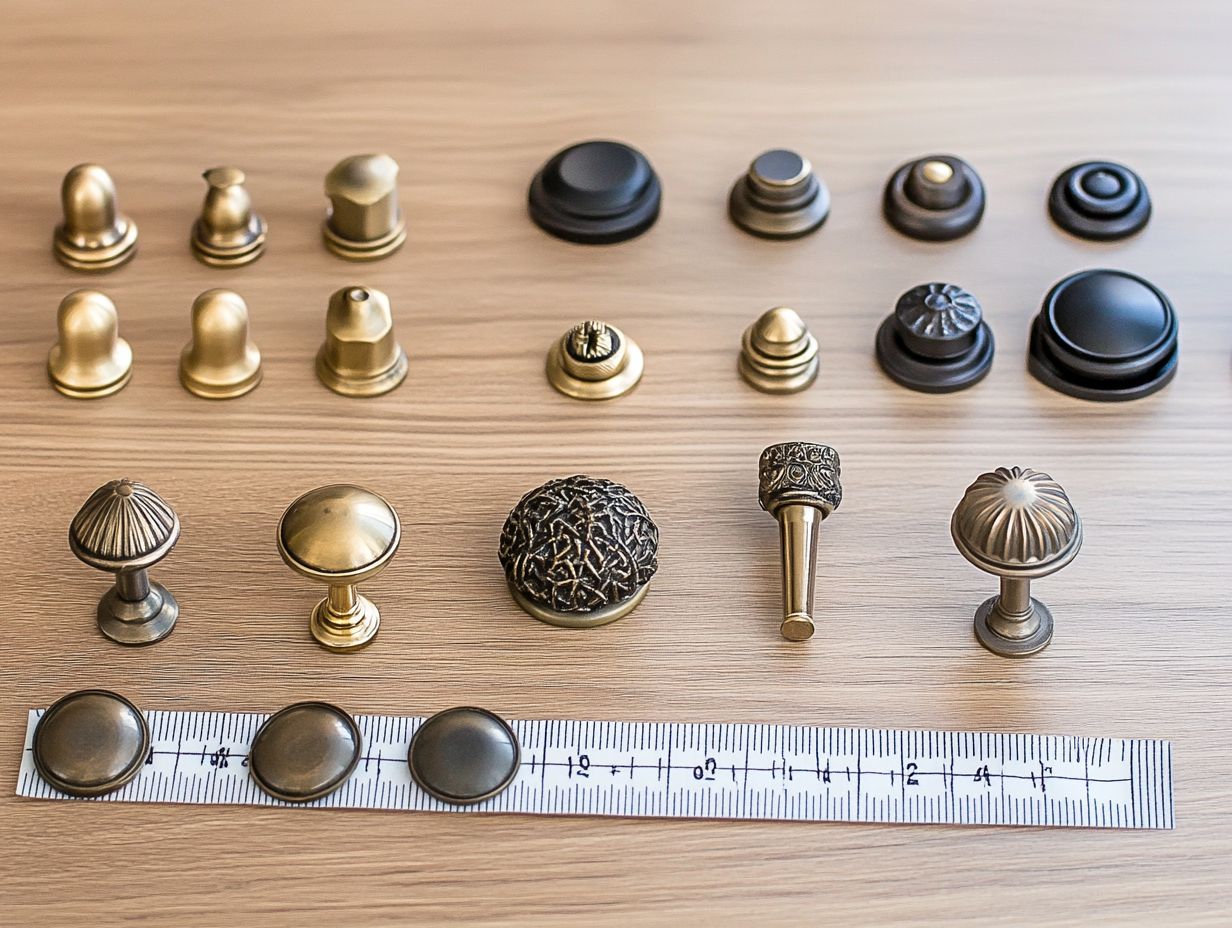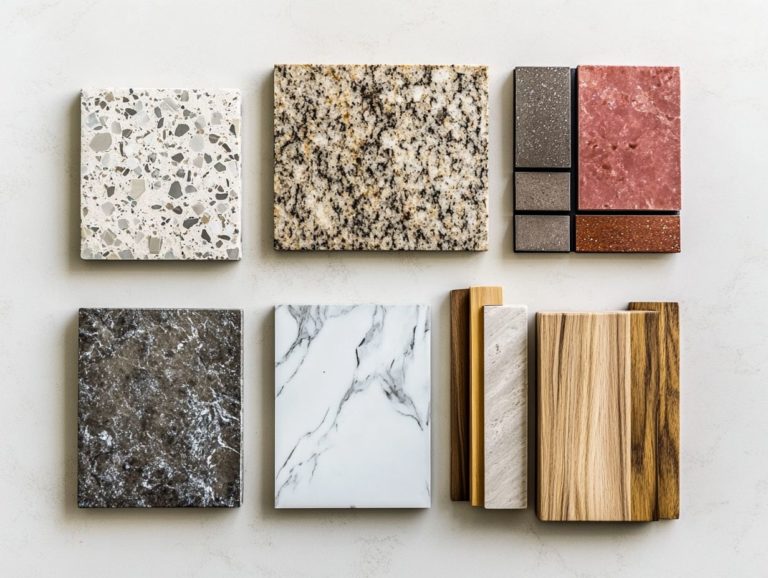Choosing the Best Cabinet Hardware for Your Kitchen
Choosing the right cabinet hardware can elevate your kitchen from ordinary to extraordinary.
With an extensive array of options at your fingertips—knobs, pulls, hinges, and drawer slides—it’s essential to select pieces that enhance your décor while providing functionality and durability.
This guide explores various types of hardware, highlights key considerations for your selection process, and offers practical installation tips.
You will find valuable insights on maintaining and caring for your hardware, ensuring it continues to shine.
Discover how the right hardware can truly transform your kitchen’s style and usability!
Contents
- Key Takeaways:
- Importance of Choosing the Right Hardware
- Types of Cabinet Hardware
- Considerations for Choosing Hardware
- Installation of Cabinet Hardware
- Maintenance and Care for Cabinet Hardware
- Frequently Asked Questions
- What factors should I consider when choosing the best cabinet hardware for my kitchen?
- What are the different types of cabinet hardware available for kitchens?
- How do I match cabinet hardware to my kitchen’s existing style?
- What are the most popular finishes for cabinet hardware?
- Can I mix and match different types of cabinet hardware in my kitchen?
- What steps should I follow when installing cabinet hardware in my kitchen?
Key Takeaways:

Choose hardware that matches your kitchen’s style.
Prioritize durability and ease of use in your selections.
Regular maintenance keeps your hardware shining and functional.
Importance of Choosing the Right Hardware
Choosing the right kitchen hardware is crucial for achieving a perfect blend of look and functionality in your space. Whether you’re designing a contemporary kitchen or refreshing a traditional one, the right cabinet hardware enhances the overall comfort and usability of your cabinetry.
By selecting appropriate stylish hardware and ensuring a cohesive look, you can elevate the design of your kitchen while ensuring that every element works harmoniously together.
Types of Cabinet Hardware
When choosing cabinet hardware, familiarize yourself with the different types available, as each serves both functional and stylish purposes.
From pulls and knobs to hinges and drawer slides, every component plays a vital role in your kitchen design. Your selection can significantly impact both the style of the hardware and the functionality of the cabinetry, whether you lean toward a contemporary, traditional, or rustic look.
Knobs vs. Pulls
Your choice between knobs and pulls is a foundational decision that significantly influences both functionality and the style of your kitchen.
Knobs offer a sleek, minimalist look, great for modern designs. Pulls provide a better grip and work well for larger drawers in rustic or traditional kitchens.
Understanding the subtle differences between these hardware types helps create a harmonious look throughout your cabinetry.
When considering placement, think about how each option interacts with the cabinetry and enhances user comfort. Knobs can contribute to a streamlined profile, while pulls improve accessibility, especially in areas where cabinets see heavy use.
Mixing metals, like stainless steel with brass accents, can add a touch of personality while aligning with your kitchen’s overall style. However, careful coordination is essential to prevent any visual discord.
This thoughtful selection not only enhances functionality but also provides an opportunity for personal expression within your kitchen space.
Hinges
Hinges are essential components of cabinet hardware, playing a pivotal role in the functionality and comfort of your kitchen cabinetry. They dictate how effortlessly your cabinet doors open and close, shaping the overall user experience in a kitchen that balances efficiency with style.
When selecting hinges, consider the cabinetry design—whether it leans contemporary, traditional, or rustic—making thoughtful choices during the installation process.
Understanding the different types of hinges available can significantly enhance your cabinetry project. For example, concealed hinges provide a sleek, modern appearance, perfect for full-overlay cabinet doors and ensuring a clean look.
On the other hand, pivot hinges suit heavier doors, offering a distinctive design for freestanding cabinets.
European hinges, a favorite in kitchen designs, guarantee precise alignment and effortless adjustments for your doors. When selecting the right hinge, consider factors such as door weight, size, and style, as well as installation requirements.
This careful attention to detail ensures both functionality and visual appeal, allowing each cabinet to operate smoothly while enhancing your kitchen’s overall design.
Drawer Slides

Drawer slides play a pivotal role in cabinet hardware. They directly influence the functionality and comfort of your kitchen’s storage solutions. Choosing the right drawer slides ensures smooth operation, granting you effortless access to your kitchen essentials—something that becomes increasingly important in bustling kitchens.
Whether you decide on side-mounted, under-mount, or soft-close slides, understanding these hardware types is essential for a successful kitchen renovation. Each type brings its own distinct features:
- Side-mounted slides are celebrated for their ease of installation and versatility.
- Under-mount slides provide a sleek aesthetic along with enhanced stability.
- Soft-close slides are a must-have—they ensure a gentle, whisper-quiet closing action, perfect for homes with young children!
When selecting drawer slides, consider the weight capacity required to support your kitchen items. Some slides are designed to handle heavier loads than others. Keeping your design preferences in mind will elevate both the style and functionality of your kitchen.
Proper installation is key. Most slides come with user-friendly guides, making it easy for DIY enthusiasts to tackle the task. If you need assistance, consulting a professional can ensure everything is installed correctly for long-lasting performance.
Considerations for Choosing Hardware
When selecting cabinet hardware, several important factors demand your attention, such as style, aesthetic appeal, functionality, and durability.
Choosing the right finishes and materials is crucial. These decisions influence not only the appearance but also the longevity of your hardware.
Mixing metals can introduce a distinctive flair to your kitchen design, allowing you to achieve either a contemporary ambiance or classic charm.
Style and Aesthetic
The style of hardware you choose plays a crucial role in defining the aesthetic of your kitchen. It influences how decorative pieces either complement or contrast with your cabinetry. Whether you lean toward sleek, modern pulls or ornate, traditional knobs, ensure that your hardware aligns with your overall kitchen design for a seamless look.
This thoughtful alignment enhances visual appeal and fosters a harmonious atmosphere in the space.
Selecting the right hardware can elevate a mundane kitchen into a striking focal point. For example, minimalist handles work beautifully with contemporary designs, while vintage-style knobs can evoke a nostalgic charm in a traditional setting. Rustic kitchens may thrive with wrought iron or distressed finishes that add warmth and character.
These design elements define your kitchen’s personality and functionality. They guide you toward choices that resonate with your unique style. Ultimately, the careful curation of these details reflects your personal taste while telling your kitchen’s architectural story.
Functionality and Durability
When selecting cabinet hardware, functionality and durability should be at the forefront of your decision-making process. These elements directly influence the comfort and usability of your kitchen. It’s essential to choose hardware that can endure daily wear while still looking appealing for your long-term satisfaction.
Understanding the right materials and designs will ensure your hardware not only enhances the aesthetics of your space but also performs effectively over the years.
By opting for high-quality metals like stainless steel or solid brass, you can significantly enhance the lifespan of your kitchen hardware. This provides it with the resistance it needs against wear and tear. Thoughtful designs that make it easier and more comfortable to use can elevate your overall user experience, making those daily tasks feel more efficient and effortless.
When you install, remember to utilize proper techniques and tools—think reinforced mounting and suitable backer plates—to boost both stability and functionality.
These considerations not only guarantee that your hardware endures but also contribute to a kitchen that is not just visually stunning but operates seamlessly.
Installation of Cabinet Hardware
Installing cabinet hardware correctly is essential for making your kitchen look good and work well. Having the right tools and materials sets the stage for a smooth process.
Understanding installation techniques ensures that pulls and knobs are positioned perfectly and operate well. A clear step-by-step guide can make this journey accessible for both DIY enthusiasts and those considering professional help.
Tools and Materials Needed

To install cabinet hardware successfully, you’ll need a few essential tools. Basic tools like a drill, screwdriver, and measuring tape are crucial for accurate measurements and securing fittings.
Specialized tools can elevate your installation experience. Quality materials also matter, as they affect the durability and aesthetics of your new kitchen hardware.
A level and a square will help you achieve perfect alignment, adding a professional touch. Specialty tools, like cabinet hardware jigs (tools that help you drill holes in the same spot on multiple cabinets), can streamline the process and reduce errors.
Choose high-grade screws and anchors to ensure a strong installation. Thoughtful choices in this area enhance the overall appearance and functionality of your kitchen.
Step-by-Step Guide
A step-by-step guide can turn a daunting task into a streamlined process, ensuring each piece is perfectly positioned for usability and visual appeal.
By following a systematic approach, you can efficiently install pulls and knobs, enhancing the comfort of your kitchen cabinetry. Pay attention to size and positioning, as they influence the overall look of your space.
Measure accurately for cabinet hardware placement to avoid future frustration and achieve a polished finish. Begin with measuring tape, pencil, and level for precise alignment.
Before drilling, create a template for easy replication across multiple cabinets. Keep the height of the pulls and knobs ergonomic for comfort.
Using a stud finder is a smart move. It helps secure your hardware effectively, preventing sagging or looseness that could detract from your cabinetry’s sleek appearance.
Maintenance and Care for Cabinet Hardware
Keep your cabinet hardware shining and working well with regular care! Understanding the cleaning requirements for different finishes ensures your hardware maintains its shine over time.
Taking proactive measures to prevent wear and tear will help keep your kitchen hardware looking immaculate and functioning smoothly. Don’t wait until it’s too late! Regularly clean your cabinet hardware to keep it looking new.
Cleaning and Preventing Wear and Tear
Cleaning your cabinet hardware is essential to keep it looking great. Different materials need unique cleaning techniques to avoid damage.
Regular maintenance prolongs the life of your hardware and enhances the look of your kitchen.
To keep your hardware pristine, use a soft cloth with mild soap and water. For antique or distressed metals, a gentle wax adds an extra layer of protection.
Regularly check for loose screws or rust spots. Tackling these issues early prevents further damage.
By following these cleaning practices and scheduling periodic checks, you’ll preserve your cabinet hardware’s beauty and function for years.
Frequently Asked Questions
What factors should I consider when choosing the best cabinet hardware for my kitchen?

When selecting cabinet hardware, think about the style, finish, functionality, durability, and budget. These factors help you find hardware that enhances your kitchen.
What are the different types of cabinet hardware available for kitchens?
Cabinet hardware includes knobs, pulls, handles, hinges, and drawer slides. Each type serves a unique purpose and adds a special touch to your cabinets.
How do I match cabinet hardware to my kitchen’s existing style?
To match hardware to your kitchen, consider its color scheme, design, and finishes. Choose hardware that complements these elements for a cohesive look.
What are the most popular finishes for cabinet hardware?
Brushed nickel, chrome, oil-rubbed bronze, and matte black are popular finishes. These versatile options suit various kitchen styles.
Can I mix and match different types of cabinet hardware in my kitchen?
Yes, mixing different types of hardware can create visual interest. Just ensure a cohesive theme where the pieces complement each other.
What steps should I follow when installing cabinet hardware in my kitchen?
First, measure and mark the placement of the hardware. Next, drill holes and attach the hardware with screws. For the best results, consider hiring a professional.





